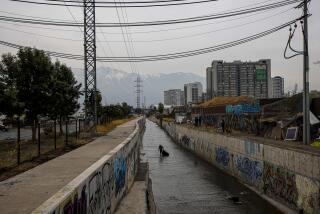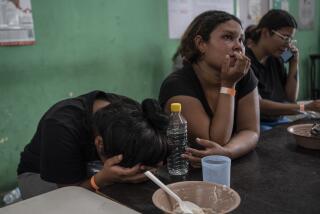Cuba Reins In Rural Rush on Havana
HAVANA â With an agility surprising for his bulk, Alberto slipped into the shadows of an archway just as a patrol car cruised past a block of crowded apartments here. When the same car drove by again, 15 minutes later, he whispered, âI gotta goâ and disappeared into a crumbling, two-story building.
Alberto is an illegal immigrant in his own country. He is among the hundreds--maybe thousands--of Cubans who must leave this capital because of a migration law that took effect in May. The government has decreed that Cubans from the countryside no longer may move to Havana without special permission.
Cuba has taken this drastic action because Havana can no longer support the huge influx of people from the poor countryside. About 55,000 arrived last year alone. Such population shifts have always existed--one-fifth of the cityâs 2.2 million residents were born elsewhere--but the numbers have soared in the past six years amid economic crisis.
As a result, this city is confronting problems that have plagued other Latin American capitals for decades: shantytowns spread on the banks of the polluted Jibaro River on Havanaâs outskirts; aunts, second cousins and godsons crowding into downtown solares, one-room flats built around a central patio with a common toilet that seldom flushes.
But unlike other countries in this hemisphere, the government here has embarked on a radical solution. And the decision to restrict migration to the capital has provoked a reevaluation of the relationship between the capital and the countryside, anger from dissidents and arguments between neighbors.
The restriction is a sharp indicator of Cubaâs inability to regain its economic equilibrium nearly six years after the collapse of communism in the former Soviet Union. It shows how its financial woes are eroding gains that Cubans thought they had made under socialism.
While such domestic migration policies were common in the old Eastern Bloc--notably in the Soviet Union--Cuba had always permitted its citizens to move freely on their own island. Now, though, the identification papers that Cubans have always been required to carry and that officials can request on demand will be used to control migration.
Human rights activists say the new law shows how President Fidel Castroâs regime still looks for authoritarian solutions to social and economic problems. More commonly, the migration law has rekindled regional resentment and become the main topic of the heated street-corner discussions that Cubans thrive on.
âAny Cuban has the right to live in Havana,â insisted Felicia, 40, a homemaker who as a child moved to the capital from Las Tunas, one of the five eastern provinces known collectively as Oriente, the countryâs poorest region. Now she lives in a cinder-block apartment building in a modest neighborhood, where she argued with neighbors a head shorter and decades younger: âIf I think I can take better care of my cousin here,â she told them, âI have the right to let her live in my home.â
But even before Felicia finished speaking, Horacio, 16, a Havana native, was shouting back: âOh, no! You come here from Oriente and you crowd up the city. You canât find work, so you turn into pickpockets. We donât want you here.â
Debating Deeply Held Tenets of Revolution
Despite the strength of their convictions, neither Felicia nor Horacio wanted to be fully identified. Thatâs because the migration law is a sensitive issue here. It strikes at deeply held tenets of the 1959 Cuban Revolution: that social injustice would be corrected and special privileges would disappear; that there no longer would be gaping differences between residents of glamorous, wealthy Havana and barefoot, uneducated fieldworkers.
Cuban officials had labored to better distribute development here, ensuring that some industries went to rural areas and away from the capital. This economic decentralization plan was highly symbolic for Cubans because their leaders--Fidel and Raul Castro--came from impoverished Oriente and fought most of the revolution there. Easterners expected the government to have a special sympathy for the problems of their underdeveloped region.
That is why the night after Cuban legislators rubber-stamped the migration law, graffiti appeared near the train station--an area where many people from Oriente live. âIf he drives the train, we will go back,â neighbors reported the scrawls said, in a reference to Fidel Castro.
The messages were quickly washed away.
The passage of the migration measure belies another reality here--that, until recently, the socialist government had made strides toward improving conditions in the countryside. In a little more than three decades, the government had shifted one-fifth of the nationâs manufacturing jobs to areas outside the capital.
In rural areas, the regime had built houses, hospitals and schools--so many schools, in fact, that almost all youngsters from Havana go to high school in the provinces, combining studies with required work in the fields. This contrasts with other Latin American countries, where farm kids must go to boarding schools in the capital.
Caught in Backwash of Eastern Blocâs Fall
Until 1990, Havanaâs population was growing more slowly than that of the nation overall, according to a recent housing report by sociologist Xiomara Franco and architect Selma Diaz. Still, the capital could not keep up with even that modest growth, housing experts admit. For example, a scale-model of Havana in the once-fashionable Miramar district shows that, since 1959, there has been far less construction in the capital than there was in the first six decades of the 20th century.
This meant that the city was utterly unprepared for the rising tide that began in 1991, when the Eastern Bloc crumbled and Cuba lost its major trading partners and sources of foreign aid. Without raw materials, factories closed, especially those outside the capital that were difficult to reach. Few goods entered Havanaâs port and even fewer made it outside the capital when lack of gasoline caused distribution systems to break down.
âIn the crisis, the situation in the countryside became more difficult,â economist Pablo Carranza said. âSome provinces have serious employment problems and Havana--the big city, more dynamic with the development of emerging economic sectors, particularly tourism--became a magnet.â
It happened to the stealthy migrant who asked to be identified only as Alberto. By 1993, he decided to drop out of architecture school in Santiago, about 460 miles southeast of the capital in the heart of Oriente. âYou canât work there, there is nothing,â he said, explaining why he moved to Havana and stayed, even though he could not find a place to live here. He and Killer, his pet boxer, have drifted from the overcrowded floor of one relativeâs home to the doorstep of another.
First, he worked in a cafeteria. Then, last year, he got a temporary job in his field, inspecting buildings to determine if they could be repaired and what would be needed to fix them.
This work ended in November--but not before Alberto had seen some of the reasons why the government imposed its migration law. Alberto said he inspected many overcrowded, rundown and ill-repaired buildings--places where the stairs were about to collapse and ceilings were falling.
As Havana Deputy Mayor Jose Rodriguez explained in an interview with the weekly newspaper Juventud Rebelde: âThe city cannot support its 2.2 million inhabitants. There are serious problems with housing, underground pipes that are more than 100 years old and an inadequate sewer system.â
Rodriguez estimated that 80,000 Havana residents live in 20,400 shacks in âunsanitary zones,â places such as El Fanguito--The Swamp, so named because it floods in the rainy season when a nearby polluted river rises. The shantytown has existed for at least 50 years, but each time officials find housing for one group, new migrants replace them.
âObviously, immigrants have added to the difficulty of providing suitable housing for everyone who lives in Havana,â said Arcel Rocha, director of the National Housing Institute, the government agency responsible for providing shelter. Restricting migration is the only way to bring order to the city, Rodriguez argued.
But in places such as El Fanguito, residents see the problem differently. This community--in the shadow of Havanaâs skyscrapers--is filled with shacks with patched-together roofs and scrap-wood walls. Its residents mainly hail from Oriente. The reason they moved to the capital is simple, said Lazaro LaRosa, 22. âI just got back from Guantanamo last night. People there are eating plantains--nothing else.â
âSolution Does Not Lie in Repressive Measuresâ
Human rights activist Elizardo Sanchez drew an analogy, saying the migration law reminded him of an angry husband who throws out the sofa where his wife entertains her boyfriend to try to put a stop to her affair. âI understand that the situation of migration from the countryside to the city has reached a critical point,â he said. âBut the solution does not lie in repressive measures, but rather in encouraging economic and social development in the most impoverished regions.â
Cuban authorities have repeatedly stated that their ability to solve the countryâs problems is severely limited by its continuing economic crisis--made worse, they say, by the U.S. embargo imposed since 1960. âThe government blames everything on the embargo,â Sanchez said. âThe truth is, they do not have money because socialist economics has failed.â
Such economic arguments mean little to Alberto, who finds himself confronting many of the same problems that illegal immigrants from Mexico and Central America face in Los Angeles.
âI applied for a job at a construction company the other day, and they asked for my papers,â he said. âThey turned me down because I didnât have legal residence.â
Relatives and friends who used to let him and his dog spend the night are growing more cautious, and he is reluctant to be seen too often in the same neighborhood, for fear he will be detected.
âI never stay too long in the same place,â he said, but added that he is determined to stay in Havana. âI would rather die than go back. Why should I have to go?â
More to Read
Sign up for Essential California
The most important California stories and recommendations in your inbox every morning.
You may occasionally receive promotional content from the Los Angeles Times.










